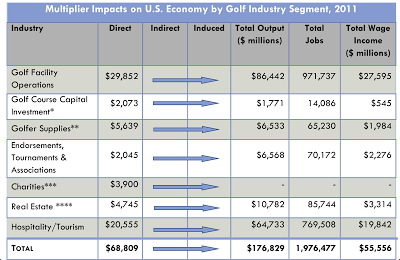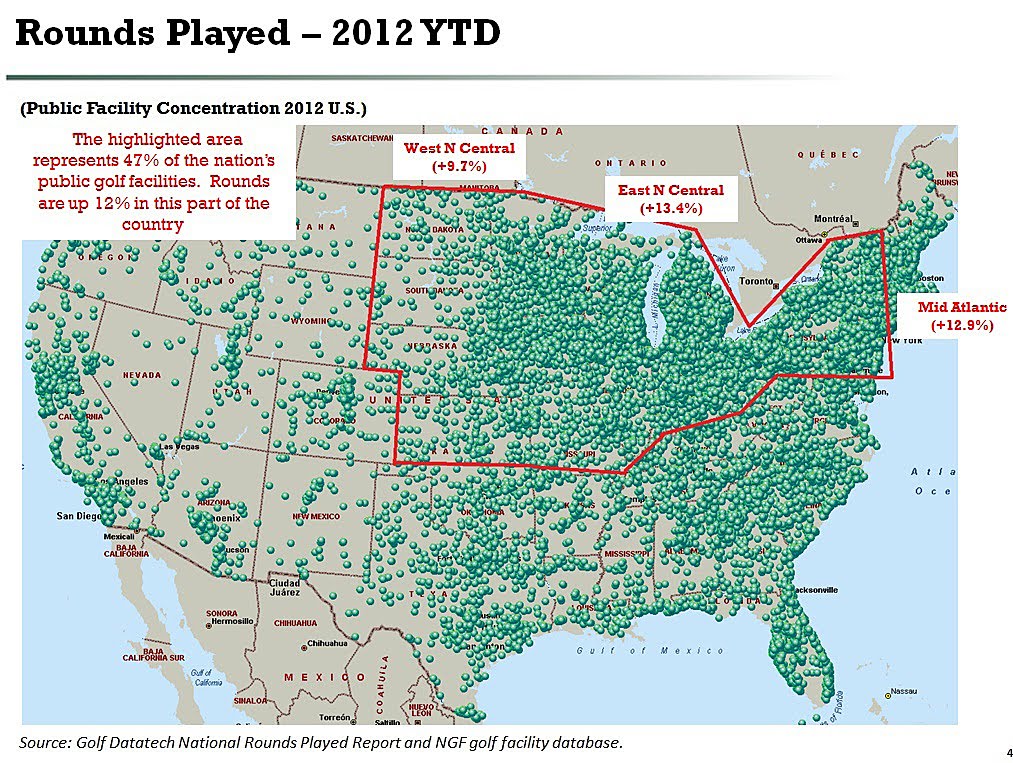 |
| Source: 2011 Golf Economy Report (golf2020.com) |
Money circulates in, through and around the golf industry – that much you know. What you might not know is just how much money. What if I told you it was in the hundreds of…wait for it…BILLIONS.
According to the latest Golf Economy Report (commissioned for the 2011 calendar year and released in October 2012 by the World Golf Foundation and Golf 20/20), the golf industry has an indirect economic impact of $176.8 billion in the United States. And, if you extrapolate that out to include everyone’s salary who is affected by a golf-related transaction, the number is even more staggering: Nearly two trillion dollars.
Such robust numbers led the report’s authors to conclude that, “The game of golf is an industry in its own right, and contributes significantly to the U.S. economy.” But how does golf pump that much cash into the system on a annual basis – especially in light of recent economic woes? Well the report boils it down to seven ways.
1) Let’s begin with golf courses. There are nearly 16,000 facilities in the U.S. (some with multiple courses) that employ nearly a million people. But beyond wages, money is spent on several other things such as maintenance (gas, fertilizer and pesticides etc.) and food and beverage (the 19th hole) – in all, golf courses are collectively responsible for contributing more than $86 billion to the U.S. economy.
2) What about hospitality and tourism? This is an area that has actually seen a rise over the last decade. People are traveling to play golf and the money they spend in relation to that travel is substantial – nearly $65 billion is in some way, shape or form correlated to golf-related travel every year.
3) We all know the real estate market has suffered over the past half decade and golf real estate (residential golf-related construction) is no exception. But it’s still the third-biggest contributor, to the tune of nearly $11 billion.
4) The next category lumps the pro tours in with associations (both national and local) and player endorsements. When Tiger and Rory sign a lucrative deal with Nike, many people benefit. This bucket contributes $6.6 billion.
5) Need a new set of clubs? Although people haven’t been spending as much on golf supplies (including equipment and apparel) over the last few years, this space still accounts for $6.5 billion annually.
6) Another thing to suffer due to the recent recession has been new course openings. And while not as much capital has exchanged hands, investors are still investing – nearly $1.8 billion on new course developments in 2011.
7) The last thing on the list might surprise you, but believe it or not, the golf industry is a bit of a philanthropist. Be it a local charity tournament or other fund raising through various organizations within golf, the industry donates nearly $4 billion a year. Top that Bill Gates!
This all adds up to that $176.8 billion indirect economic impact I mentioned earlier – and this is just within the United States! There’s no doubt golf contributes much more on a global scale.
So the next time you’re walking alone down a quiet fairway, just remember – every ball you lose; every dollar of your greens fees; every soft spike you wear-down contributes in some small way to the economic juggernaut that is the golf industry.
The complete report can be found HERE.




Great tips! That’s how great a golf package is!